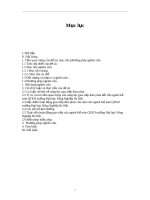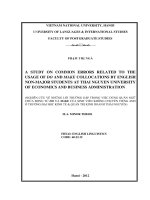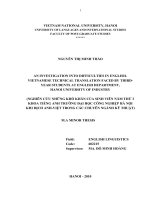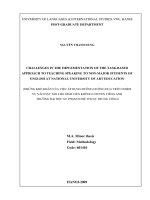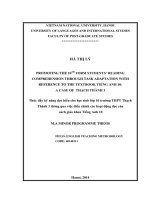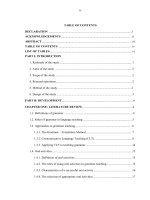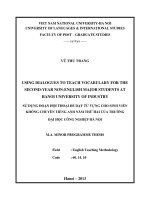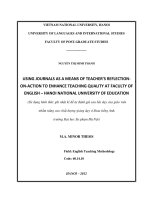Hỗ trợ kỹ năng đọc hiểu cho sinh viên không chuyên tiếng Anh trường Đại học Công nghệ Hà Nội thông qua việc điều chỉnh các hoạt động đọc của giáo trình New Head
Bạn đang xem bản rút gọn của tài liệu. Xem và tải ngay bản đầy đủ của tài liệu tại đây (3.16 MB, 64 trang )
VIETNAM NATIONAL UNIVERSITY, HANOI
UNIVERSITY OF LANGUAGES AND INTERNATIONAL STUDIES
FACULTY OF POST-GRADUATE STUDIES
*****
®Æng thÞ lª na
SUPPORTING STUDENTS’ READING COMPREHENSION
THROUGH TASK ADAPTATION WITH REFERENCE TO THE NEW
HEADWAY PRE-INTERMEDIATE COURSEBOOK AT HANOI
UNIVERSITY OF INDUSTRY
HỖ TRỢ KĨ NĂNG ĐỌC HIỂU CHO SINH VIÊN KHÔNG
CHUYÊN TIẾNG ANH TRƯỜNG ĐẠI HỌC CÔNG NGHIỆP HÀ NỘI THÔNG
QUA VIỆC ĐIỀU CHỈNH CÁC HOẠT ĐỘNG ĐỌC CỦA GIÁO TRÌNH NEW
HEADWAY PRE-INTERMEDIATE
M.A MINOR PROGRAMME THESIS
ENGLISH METHODOLOGY
60 14 10
HANOI, 2010
VIETNAM NATIONAL UNIVERSITY, HANOI
UNIVERSITY OF LANGUAGES AND INTERNATIONAL STUDIES
FACULTY OF POST-GRADUATE STUDIES
*****
®Æng thÞ lª na
SUPPORTING STUDENTS’ READING COMPREHENSION
THROUGH TASK ADAPTATION WITH REFERENCE TO THE NEW
HEADWAY PRE-INTERMEDIATE COURSEBOOK AT HANOI
UNIVERSITY OF INDUSTRY
HỖ TRỢ KĨ NĂNG ĐỌC HIỂU CHO SINH VIÊN KHÔNG
CHUYÊN TIẾNG ANH TRƯỜNG ĐẠI HỌC CÔNG NGHIỆP HÀ NỘI THÔNG
QUA VIỆC ĐIỀU CHỈNH CÁC HOẠT ĐỘNG ĐỌC CỦA GIÁO TRÌNH NEW
HEADWAY PRE-INTERMEDIATE
M.A MINOR PROGRAMME THESIS
Field: English Teaching Methodology
Code: 60 14 10
Supervisor: Lê Văn Canh, M.A
HANOI, 2010
v
TABLE OF CONTENTS
Page
Declarations i
Acknowledgements ii
Abstract iii
List of Abbreviations iv
List of Tables and Figures iv
Table of Contents vi
PART I: INTRODUCTION 1
1. Identify the Problem 1
2. Aims of the Study 1
3. Research Questions 1
4. Significance of the Study 2
5. Scope of the Study 2
6. Methods of the Study 2
7. Design of the Study 3
PART II: DEVELOPMENT 5
Chapter One: Literature Review 5
Introduction 5
1.1. Overview on Reading, Task and Task Adaptation 5
1.1. Definition of Reading Comprehension 5
1.2. The Role of Reading in Foreign Language Learning 5
1.3. Challenges of Comprehending Reading Texts 6
1.3.1. Reading Problems 6
1.3.2. Language Problems 7
1.3.3. Cultural and Background Knowledge Problems 7
1.4. Task Adaptation as a Type of Support for the Reading
Comprehension Process 8
1.4.1. Definition of Task 8
1.4.2. Definition of Adaptation 9
1.4.3. The Purpose of Adaptation 9
vi
1.4.4. Categories of Adaptation 10
Chapter Conclusion 10
Chapter Two: The Study 11
Introduction 11
2.1. Situation Analysis 11
2.1.1. Setting of the Study 11
2.1.2. The Learners 11
2.1.3. Reading Materials 12
2.2. Instrumentation and Procedures 12
2.3. The Adaptation of Reading Tasks in the Coursebook 13
Chapter Conclusion 18
Chapter Three: Data Analysis 19
Introduction 19
3.1. Data Analysis of Preliminary Survey 19
3.2. Data Analysis of Survey Questionnaire 21
3.3. Data Analysis of Survey for Response to Adaptation 24
3.4. Reflection 28
Chapter Conclusion 30
Chapter Four: Major Findings and Suggestions 31
4.1. Major Findings and Discussions 31
4.2. Suggestions 35
PART III: CONCLUSION 39
1. Conclusion 39
2. Limitations and Recommendations for Follow-up Action 40
REFERENCES 41
APPENDIXES
Appendix 1: Preliminary Survey
Appendix 2: Survey Questionnaire
Appendix 3: Worksheets (delivered in class)
Appendix 4: Samples of Adapted Reading Tasks
Appendix 5: Survey for Response to Adaptation
Appendix 6: Original Reading Sections (Unit 2, Unit 4, and Unit 7)
iv
LIST OF ABBREVIATIONS
HaUI: Hanoi University of Industry
GE: General English
ESP: English for Specific Purposes.
ESL: English as a Second Language
EFL: English as a Foreign Language
CUP: Cambridge University Press
LIST OF FIGURES AND TABLES
Figure 1.1. The Vicious Circle of the Weak Reader
LIST OF FIGURES AND TABLES
Table I.1: Steps in Action Research Cycle
Table 3.1: The Students’ Perception of the Role of Reading Comprehension
Table 3.2: The students’ Evaluation of Reading Lessons
Table 3.3: Elements Affecting the Students’ Reading Comprehension
Table 3.4: The Students’ Evaluation of the Role of Reading Materials
Table 3.5: The Students’ Opinions towards the Language in Reading Texts
Table 3.6: The Students’ Opinions towards the Content of Reading Texts
Table 3.7: The Students’ Opinions towards the Reading Tasks
Table 3.8: The Students’ Preferences for Reading Tasks
Table 3.9: The Students’ Opinions on Tasks of the Reading Stages Needed
Adapting
Table 3.10: The Students’ Response to the Reading Lesson of Unit 2
Table 3.11: The Students’ Response to the Reading Lesson of Unit 4
Table 3.12: The Students’ Response to the Reading Lesson of Unit 7
1
PART I: INTRODUCTION
1. Identify the Problem
In Vietnam, English is taught and learnt in a non-native environment so reading is
perhaps the most important skill as it provides students with access to written materials.
Teaching and learning English in general and teaching reading in the context of Hanoi
University of Industry is receiving more attention because reading helps students increase
knowledge of English through exposure to the target language as well as sources of
valuable information. It is crucial for them to acquire the skills to read English efficiently.
However, as a teacher of English at HaUI for nearly 4 years, I find that my
students, especially the first-year ones, are quite bored with the reading tasks offered in the
coursebook “New Headway Pre-Intermediate”, the second edition. Doing reading tasks
sometimes is a burden for them. Students often participate in reading lessons inactively and
inefficiently.
The fact has urged the author to carry out the study with the view to supporting
students‟ reading comprehension through task adaptation. Hopefully, this study will make
contributions to improving the learning of reading in particular and that of English in
general at HaUI.
2. Aims of the Study
The study was designed to support students‟ reading comprehension through the
adaptation of reading tasks in the coursebook New Headway Pre-Intermediate. It aimed to
achieve three primary objects:
1. To investigate how interesting and relevant the students find the current reading
materials and reading tasks.
2. To identify unsuitable aspects of the reading tasks in the coursebook New
Headway Pre-Intermediate and adapt them.
3. To make some suggestions for supporting students‟ reading comprehension
through task adaptation.
3. Research Questions
In order to achieve the above-mentioned aims, the following research questions
guided the study:
2
1. What reading comprehension tasks in the coursebook New Headway Pre-
Intermediate do the students feel challenging?
2. Why do they feel those tasks challenging?
3. In what way are those tasks adapted in order to help them cope with the reading
tasks better according to the students‟ evaluation?
4. Significance of the Study
The study was carried out to encourage the students‟ assessment of reading tasks in
the coursebook. The unsuitable tasks were adapted to be more practical and accessible for
the students. Pedagogically, the findings of the study are believed to bring about necessary
changes in reading materials and teaching methodology to improve the students‟ reading
comprehension at HaUI.
Furthermore, the suggestions for teaching reading based on the findings can be
useful for concerned teachers to make reading lessons more interesting and effective.
5. Scope of the Study
Materials adaptation is such a broad topic that cannot be wholly discussed within
the framework of this paper, therefore, only one specific aspect will be central to the
discussion that is reading tasks‟ adaptation.
With the focus on reading tasks only in the coursebook New Headway Pre-
intermediate, the second edition, the study was carried out to adapt those which are
inappropriate according to the students‟ evaluation to support their reading comprehension.
The study focuses on the first year students, non-major English, so the results of the
study are not applied for all students at HaUI.
6. Methods of the Study
The study in fact is a mini action research carried out with the following steps:
Step 1:
Initiation
- In the process of teaching the coursebook New Headway Pre-
Intermediate, the author observed that reading lessons are not
always interesting enough to students, they often participate in
reading lessons inactively and inefficiently meanwhile reading
comprehension is considered important to academic studies. What
should be done?
Step 2:
- The author carried out the preliminary survey to find out major
3
Preliminary
investigation
reasons why they are not interested in reading lessons.
Step 3:
Hypothesis
- By collecting and reviewing the baseline data, the author came to
the hypothesis that the students were fed up with reading lessons
mainly because they often encountered problems with language,
reading strategies and background knowledge.
Step 4:
Intervention
- Before each new unit, the students were surveyed to find out their
opinions about reading tasks in the coming lesson.
- The author selected some reading tasks that the students assessed
to be unsuitable and suggested different types of adapted tasks.
- The adapted tasks were delivered in the next lesson. The author
observed the class, recorded the results.
- When the students finished the tasks, the author provided them
with survey questionnaires for response to adaptation.
Step 5:
Evaluation
- The students found the adapted tasks less challenging and
achievable. They were more comfortable when doing those tasks
and took part in reading lessons more actively.
Step 6:
Dissemination
- The author discussed about the effectiveness of adapted tasks to
the students.
Step 7:
Follow-up
- The author suggested more adapted activities to teach other
reading sections basing on the coursebook New Headway Pre-
intermediate to the students.
Table I.1: Steps in Action Research Cycle (Adopted from Figure 1.5, Nunan, 1992:19)
7. Design of the Study
The study titled “Supporting Students‟ Reading Comprehension through Task
Adaptation with reference to the New Headway Pre-Intermediate Coursebook at Hanoi
University of Industry” consists of three main parts namely Introduction, Development and
Conclusion.
In the first part- Introduction- the reason for the research, aims, significance, scope
and methodology of the study are considered.
The second part- Development- contains four chapters.
4
- Chapter One focuses on theoretical background of the study which is about
reading comprehension, reading tasks and task adaptation.
- Chapter Two not only describes the context of teaching and learning English at
HaUI but also presents the instrumentation of the study as well as the adaptation of tasks.
- Chapter Three deals with a comprehensive data analysis.
- Chapter Four reports major findings, discussion, and suggestions.
The last part- Conclusion- provides a summary of the study, limitations and
recommendations for follow-up action.
5
PART II: DEVELOPMENT
CHAPTER ONE: LITERATURE REVIEW
Introduction
This chapter aims at providing a theoretical background knowledge relating to
reading comprehension and task adaptation for the study.
1. Overview on Reading Theories, Task and Task Adaptation
1.1. Definition of Reading Comprehension
Attempts to define reading have been numerous. Williams (1984: 2) defines
reading simply as “a process whereby one looks at and understands what have been
written.” Ur (1996: 38) shares the same view when he defines “reading means reading and
understanding.” Or according to Karlin and Kartin (1988: 2)‟s view “reading without
reading comprehension is meaningless”. In these ways of definition, merely reading
without understanding does not count as reading. The problem in defining is the confusion
between „understanding‟ and „comprehending‟. It seems that the two words are used
interchangeably. For example, according to Grellet (1981: 3), “reading comprehension or
understanding written texts means extracting the required information from it as efficiently
as possible.” In a similar way, Richard and Thomas (1987: 8) do not make any distinction
between the two terms. They define reading comprehension as “an understanding between
the author and the reader”. To their view, reading comprehension is not just a matter of
simply knowing what the author intends but it is the process whereby the printed pages
stimulate ideas, experiences and responses that are unique to an individual.
In short, reading comprehension is an interactive process that goes on between the
reader and the text, between the readers‟ existing knowledge and the information suggested
by the text being read. The text presents letters, words, sentences, and paragraphs that
encode meaning. The reader uses knowledge, skills, and strategies to understand or
comprehend the meaning of the text.
1.2. Role of Reading in Foreign Language learning
The role that reading plays in language acquisition continues to be an area of
research in second language learning. In teaching and learning English as a foreign
6
language in Vietnam, reading has always received a great deal of attention. This is because
reading gives learners access to written materials and facilitates other language skills to
help them have good command of English. Thus, reading skill is not only an important
means to gain knowledge but also a means by which further study takes place. In other
words, learners read to learn. The importance of reading skill is acknowledged in Carrel‟s
(1981: 1) view, “for many students, reading is by far the most importance of the four skills
in a second language, particularly in English as a second or foreign language”. Enhancing
learners‟ reading skills is crucial because according to Richard (1993: 9), “becoming an
effective and influent reader in another language has a number of important benefits for the
learner.” Anderson (1999: 1) while regarding the importance of reading writes, “with
strengthened reading skills, ESL/EFL readers will make greater progress and attain greater
development in all academic areas.” Bearing this point in mind, it is a mandatory duty for
each ESL teacher to develop learners‟ reading comprehension in general and developing
vital reading skills in particular.
1.3. Challenges of Comprehending Reading Texts
Reading in a foreign language is of great importance to academic studies, personal
development and professional success. However, reading in a foreign language is much
more difficult. Many scholars agreed that there are three main factors that affect reading
comprehension: (1) reading ability, (2) language proficiency, and (3) cultural and
background knowledge.
1.3.1. Reading Problems
If a reader has a poor reading ability in his first language, he cannot read well in a
second language as Bernhardt and Kamil (1995: 17) assume “reading performance in a
second language is largely shared with reading ability in a first language”. Besides,
according to Alderson (1984), the reason why learners who fail to read adequately in
English is that they cannot read efficiently in the native language. Obviously, reading
process in a second language is slower than that of the first one as it depends on lots of
factors. For most learners, their limited reading skills create many problems. Very
frequently, students feel difficult to use the appropriate ways to read. They just look at
every word, read slowly from the beginning to the end. Sometimes, they may encounter
new words or unfamiliar topic, cannot concentrate well on the text and finally fail to grasp
the general meaning. Usually, there are unfamiliar words, new structures and ideas in
7
reading text. If a learner does not have strategies and skills to make use of lexical,
grammatical, logical, and cultural clues he will read the text with less comprehension. And
poor reading comprehension may result in disinterest in reading. He may be trapped in a
vicious circle:
Doesn‟t understand → Read slowly
↑ ↑
Doesn‟t read much → Doesn‟t enjoy reading
Figure 1.1. The Vicious Circle of the Weak Reader (Nuttal, 1996: 127)
1.3.2. Language Problems
Yorio (1971: 108) contends that reading problems of foreign language learners are
largely due to the imperfect knowledge of the target language and the mother tongue
interference in the reading process. Concerning language problems, Levine and Reves
(1990: 37) write, “lack of adequate vocabulary as one of the obstacles to text
comprehension” (cited in Anderson, 1999: 25). Obviously, low competence in the target
language hinders readers from reading efficiently. Dealing with a reading text, learners
may have to face with difficulties of „text‟ and „vocabulary‟. The first problem of „text‟
happens when learners have to work with unfamiliar and difficult topics in a text with lots
of new grammatical structures. They do not have any motivation to keep on reading as the
text is challenging to understand. The second frequent problem is caused by „vocabulary‟.
For any foreign language readers, there is always new vocabulary in reading texts.
Vocabulary problems occur when readers dealing with proverbs, idioms, synonyms,
antonyms, etc. because they cannot interpret their real meanings in context. Therefore
when knowledge of vocabulary and grammatical structures is restricted, the readers have
lots of difficulties. As a result, they will be unwilling to explore the text.
1.3.3. Cultural and Background Knowledge Problems
Background knowledge includes all experience that a reader brings to a text such as
life experience, educational experience, and knowledge of how texts can be organized
rhetorically. Nunan (1989: 33) discusses on the significant role of background knowledge
in reading comprehension through „schema theory’. According to this theory, reading is an
interactive process between what a reader already knows about a given topic and what the
8
author writes. The way we interpret depends on the schemata activated by the text. Hence,
many readings passages can only be adequately comprehend if the reader has the relevant
cultural knowledge.
Strang (1972) thinks that different readers have different levels of comprehension of
the same text because they start off from different positions. In a similar vein of thinking,
Osman (1985) finds that readers coming from different cultural backgrounds interpret texts
differently because of the differences in the high-level cultural schemata that were
activated. When dealing with a reading text, a reader may encounter the problem of an
unfamiliar topic. Comprehension of a culturally unfamiliar text is more difficult because
readers may misinterpret the text according to their own cultural experiences. The new
content of the text prevents readers from comprehending the text properly which may
make them lose their interest in exploring the text. As Carell and Eisterhold (1983: 560)
point out “a reader‟s failure to activate an appropriate schema during reading results in
various degree of non comprehension” (cited in Anderson, 1999: 12).
1.4. Task Adaptation as a Type of Support for the Reading Comprehension Process
The previous sections discuss reading comprehension and its related aspects. This
current section is intended for task adaptation.
1.4.1. Definition of Task
In Breen‟s (1987: 26) words, “a language learning task can be regarded as a
springboard for learning work. In a broad sense, it is structured plan for the provision of
opportunities for the refinement of knowledge and capabilities entailed in a new language
and its use during communication”, (cited in Richards and Rogers, 2001: 223). According
to Prabhu (1987: 17), a task is “an activity which requires learners to arrive at an outcome
from given information through some process of thought, and which allows teachers to
control and regulate that process”. The ideas cover sufficient features and functions of
tasks in language acquisition. Obviously, a task is a practical implementation of teaching
objectives to facilitate the process of language acquisition of learners.
To specify a language learning task, in the context of teaching reading
comprehension Scrivener (2005: 188) recommends a framework of 15 specific reading
tasks such as reordering, listing, responding, problems solving, predicting, etc. These are
actually tasks which are aimed to develop students‟ various micro-reading skills. The
9
concept of „reading comprehension tasks‟ in this study is used with reference to this
framework.
1.4.2. Definition of Adaptation
There are numerous definitions of adaptation given by different scholars.
Tomlinson (1998: xi) refers to adaptation as “making changes to materials in order to
improve them more suitable for a particular type of learner”. With regard to adaptation
techniques, Madsen and Bowen (1978: ix-xi) point out that adaptation is the action of
employing “one or more of a number of techniques: supplementing, editing, expanding,
personalizing, simplifying, modernizing, localizing, or modifying cultural/situational
content”. With an emphasis on the relationship between teachers and materials, Stevick
(1972: 83) describes adaptation as bridging a gap: “the teacher must satisfy the demands of
the textbook, but in ways that will be satisfying to those who learn from it”.
In general, adaptation tends to be thought of as a rather formal process in which the
teacher makes decisions about teaching materials that needs changing, and then wrote out a
revised version for the class, counting for different factors to make the materials more
accessible and practical to the teaching context.
1.4.3. The Purpose of Adaptation
No one book can be perfect for a particular teaching-learning context. In fact, a
coursebook can never be totally an effective tool for teachers to follow without any
adaptation because of its intrinsic deficiencies such as linguistic inaccuracies, out-of-
datedness, lack of authenticity or lack of variety. Thus, the author favors Madsen and
Bowen‟s (1978) and Tice‟s (1991) view that is the purpose of adaptation is to “compensate
for those deficiencies” (cited in McGrath, 2002: 64).
Another purpose of adaptation, as explained by Mc Donough and Shaw (1993: 85)
is “to maximize the appropriacy of teaching materials in context, by changing some of the
internal characteristics of a coursebook to better suit our particular circumstances.”
Maximizing the appropriacy of teaching materials by different techniques to make them
more relevant, accessible and useful for learners is important because it can stimulate
motivation, and increased motivation is, in turn, likely to lead to a classroom atmosphere
more conductive to learning.
Concerning the role of motivation in language learning, McGrath
(2002: 67) acknowledges that one of the practical reasons for adaptation is “to maintain
10
learners‟ interests by varying what might be a rather repetitive diet”. Maintaining students‟
motivation is important because motivation directly affects the extent of students‟
involvement and performance in language learning.
1.4.4. Categories of Adaptation
There are a number of techniques for adaptation depending on teacher‟ purposes
and teaching context. Within the scope of this research, some frequently-used ones will be
discussed with reference to the discussion of McGrath (2002) and McDonough and Shaw
(1993) that „adaptation‟ refers to some techniques of change and addition.
Regarding to techniques for adaptation, McGrath (2002: 64-67) divides them into
two categories: adaptation as addition and adaptation as change. The former includes 3
forms of adaptation such as extemporisation, extension, and exploitation. The later presents
a principled approach to adaptation and foci and forms of change. Sharing the same
concerns, McDonough and Shaw (1993: 36) developed “external criteria” and “internal
criteria” for adaptation. According to these authors, both external criteria and internal
criteria when considered together would determine how the task could be localized,
personalized, individualized. Then the teacher makes decision on whether to add, to delete,
to modify, to simplifying or to reorder the tasks regarding the language practice, texts,
skills, etc. The limitation of this framework is that the adaptation techniques are limited
just to 5 different techniques. This does not reflect fully the complexity of the classroom
and the diversity of coursebook in use.
Chapter Conclusion
To conclude, this chapter has presented a brief review of related knowledge which
will be the theoretical foundation for the interpretation of data and suggestions in the next
chapters.
11
CHAPTER TWO: THE STUDY
Introduction
This chapter will analyze the situation of the study with the description of the
subjects, the materials used by the students and the instruments applied to collect data.
2.1. Situation Analysis
2.1.1. Setting of the Study
The study was conducted at Hanoi University of Industry (HaUI). The university
was officially established in December 2005 on the basis of Hanoi Industrial College, one
of the leading vocational colleges in Vietnam where thousands of skilled workers and
engineers are trained every year.
At HaUI, English is taught as a compulsory subject and a pre-requisite for
graduation because it is considered to be useful both for students‟ studies and their future
jobs. English training program is divided into two courses: General English and English for
Specific Purposes. Of the total 5 semesters, the first 4 terms are designed as a GE course to
help students acquire English at pre-intermediate level. During this stage, students study 60
periods of English in each semester. However, there is only two periods of reading a week.
Totally, there are 20 periods of reading a semester. The last semester is devoted to
introduce ESP content with a focus on reading and translating documents relating to
students‟ majors.
2.1.2. The Learners
The study was carried out with the participation of 98 students of two English
classes from Automation & Electronics, and Electrical Engineering Departments. In
general, the students are at the age of 18-22. They are mostly male students. They come
from different provinces of Vietnam. The majority of them are from the countryside. Some
of them have never studied English before but there are lots of students who have learnt
English since they were at grade 6. At the beginning of the first term, the students were
grouped according to their English placement test results. The results showed that most of
them were at beginner‟s level. In fact, English is not their major, so they do not pay much
12
attention to study English. At the time of the study, the students were in the second term of
their first year.
2.1.3. Reading Materials
The New Headway series, the second edition (New Headway Beginner, New
Headway Elementary and New Headway Pre-intermediate) by John and Liz Soars
published by OUP are used as the main coursebooks providing students with thorough
coverage of basic grammatical and lexical items and language skills.
The New Headway Pre-Intermediate is used for the first year students, who have
finished the New Headway Elementary. Since last year, the coursebook New Headway
Pre-Intermediate has been divided into 2 stages of learning called English credit 2 and 3.
Each stage covers 7 units. Reading lessons in the coursebook follow three stages pre-
reading, while-reading and post-reading. The reading texts are long with a great deal of
new words and grammatical structures, requiring good reading strategies.
2.2. Instrumentation and Procedures
This mini action research was conducted based on the data collected from „student-
based evaluation‟ and „response-based evaluation‟ (Ellis, 1997: 39-40). The former
regarded the students‟ attitudes to the reading tasks to check whether they are enjoyable or
useful. Therefore, the data was practical and reliable. The later required the teacher to
examine the actual outcomes (both the products and processes of the tasks) to see whether
they matched with the students‟ motivation and teaching objectives. Although response-
based evaluations were time-consuming and quite demanding, they did provide valuable
information regarding whether the task was achieving what was intended to achieve.
Questionnaires were utilized as the main data collection instruments and class
observation was functioned as a supplementary source of information. Because all the
informants gave answers to the same questions, the data collected from the questionnaires
was quite easy to summarize, analyze and report. Besides, the informants had chance of
presenting their ideas in a free way without having to provide personal information. As a
result, the researcher had more uniform and accurate data.
To avoid misunderstanding and ensure the accuracy of the data, both types of
questionnaires were written in Vietnamese and distributed with the author‟s clear
explanation.
13
In order that the participants were not under pressure of time, the time for
responding to a survey questionnaire is 15 minutes before and after each reading lesson in
class.
The instrument and procedures used to gather the information for the study will be
described as follows:
2.2.1. Instrument 1: Preliminary Survey
The Preliminary Survey Questionnaire (see Appendix 1) was delivered to the
students at the beginning of the second term of their first year, after they have finished the
coursebook New Headway Elementary. It was designed with a mixture of closed and open
questions with two parts. Part one consists of 4 questions seeking information about
students‟ sex, major, homeland, time of learning English and English result of the previous
semester. Part two includes four questions focusing on finding the students‟ general
attitudes towards: the role of reading comprehension (Question 1), reading lessons (Question
2), elements affecting reading comprehension (Question 3), and the role of reading materials to
their interests (Question 4).
2.2.2. Instrument 2: Survey Questionnaire
This questionnaire (see Appendix 2) was designed with five open and closed questions. It
was administered before each new reading lesson to obtain the students‟ evaluative opinions of
reading texts in terms of content, language, and reading tasks in each unit.
2.2.3. Instrument 3: Class Observation Sheets
The class observation sheets were used to record students‟ performance in
classroom. This was a useful means to measure students‟ attitudes, behavior and
interaction when adapted tasks were employed.
2.2.4. Instrument 4: Survey for Response to Adaptation
In order to measure the effectiveness of the adapted tasks, the Survey for Response
to Adaptation (see Appendix 5) was delivered to the students after finishing reading
lessons with adapted tasks. The follow-up questionnaire consists of 7 items. The students
were asked to self- rate the usefulness of the adapted tasks in reading lesson.
2.3. The Adaptation of Reading Tasks in the Coursebook
There are various techniques for adapting tasks depending on teacher‟s purposes
and teaching context. Basing on the findings from the students‟ evaluation of reading tasks,
14
some common adapting techniques were employed such as „replacing‟, 'adding',
'modifying', and 'simplifying' to make the challenging and unsuitable tasks of unit 2, unit 4
and unit 7 more accessible to the students at the teaching context of HaUI.
Samples of Adaptation
1. Replacing
*Sample 1.1: Unit 2- (see Appendix 4, sample 1.1)
Rationale for Adaptation:
As jigsaw reading tasks, the while-reading tasks (task 2, task 3, and task 4, see
Appendix 6, Unit 2) aim at developing group-work practice with the model of 3 groups
reading about one of three characters in the text respectively then retelling other groups
about the character he/she has read. As a matter of fact, the class size sometimes hinders
teachers from carrying out group-work effectively. It is hard to accomplish the task well
with 49 students in class. Furthermore, the students‟ language proficiency was not
adequate enough to deal with the tasks. Regarding the students‟ opinions that the tasks
were complicated, the author replaced the original tasks by the adapted version.
Adapted Version:
- Type of activity: individual and pair work
- Aims: to help the students practice and facilitate skimming and scanning skills by
finding details in the reading text
- Task: while-reading task, completing the given table with details
- Preparation: make one copy of the worksheet for each student
- Time: 15 minutes
- Procedure:
+ After finishing pre-reading task (task 1) in the coursebook, the teacher asked the
students to work individually first to read through the text, then fill in the table with
specific details from the text. At the same time, reminded them of combining scanning and
skimming skills to fill in the table.
+ The students exchanged their work with a partner.
+ The teacher checked the answers with the whole class.
2. Adding
*Sample 2.1: Unit 4-(see Appendix 4, sample 2.1)
15
Rationale for Adaptation:
The reading section of Unit 4 (see Appendix 6) was regarded a difficult one
according to the students‟ assessments because the text itself contains a great deal of
complicated words, phrases and new grammatical structures. Thus, the adapted version of
task 1 in the coursebook was added.
Adapted Version:
- Type of activity: individual work
- Aims: to provide the students with essential vocabulary in the text with the
emphasis on parts of speech and collocations
- Task: pre-reading task, matching two groups of items
- Preparation: prepare one copy of the worksheet for each student
- Time: 12 minutes
- Procedure:
+ After finishing the first pre-reading task, the teacher asked the students to look
through the second pre-reading task and drilled the pronunciation.
+ The teacher reminded the students of some learnt words in the table. In fact, most
of them were rarely-used that the students felt not easy to recall. Then, the teacher used
some techniques of teaching vocabulary to make sure that the students know the meaning
of words in one column.
+ The teacher reminded the students of not looking at the text, and encouraged
them to do the matching. The students exchanged their answers in pairs.
+ The teacher elicited answers from the students then checked the answers with the
whole class.
*Sample 2.2: Unit 7- (see Appendix 4, sample 2.2)
Rationale for Adaptation:
As a long text in the format of an interview, the reading text of Unit 7 (see
Appendix 6) offers lots of ambiguous words that need clarifying in context. Concerning the
ideas of the students about vocabulary of the reading text, the author wanted to bring a new
air into vocabulary teaching by adding the adapted version.
Adapted Version:
- Type of activity: pair work
16
- Aims: to enhance the students‟ ability of guessing meanings of words in context
- Task: pre-reading task, guessing the meaning of word in context
- Preparation: make one copy of the worksheet for each student
- Time: 10 minutes
- Procedure:
+After raising the topic about famous people in the task 1 and 2 in the coursebook,
the teacher asked the students to look at the worksheet.
+ The teacher went through the pronunciation of these words. Most of the words
were not new to the students but it was not easy to understand them in these certain
contexts.
+ The teacher asked the students to work in pairs to identify meanings of these
words in contexts.
+ The teacher elicited answers from the students then checked the answers with the
whole class.
3. Simplifying
*Sample 3.1: Unit 4-(see Appendix 4, sample 3.1)
Rationale for Adaptation:
Task 1 of unit 4 (see Appendix 6) is really culture-bound. To fulfill the task
effectively, the students must have broad background knowledge because it requires them
to match the names of some famous shopping centers in the world with their well-known
products. It is not suitable for the students because most of them come from remote
villages and towns of Vietnam. According to the survey, the students felt unfamiliar with
the content and the text itself, regardless of task 1 in the coursebook. It is essential to think
of a new way to make the lesson less complicated and encourage the participation of the
students.
Adapted Version:
- Type of activity: group work
- Aims: to help students practice discussing about a practical and familiar topic
„shopping‟ with the given prompt to arouse interest for the new lesson
- Task: pre-reading task, discussing on the same topic of the text with prompt
- Preparation: make one copy of the worksheet for each student
17
- Time: 10 minutes
- Procedure:
+ The teachers asked the students to work in groups of 3-4 or and decide: “What is
the best shopping place in Hanoi?” with the prompt: “I/We think is the
best place for shopping in Hanoi because ”
+ The teacher went round the class during the discussion then called some
representatives to express their opinions.
*Sample 3.2: Unit 7, (see Appendix 4, sample 3.2)
Rationale for Adaptation:
For most reading lessons in the coursebook, the post reading stage contains a
discussion which is quite easy to follow. But in case of unit 7, the post-reading task (task 7,
see Appendix 6) seems impractical for students. Moreover, the students are not really
proficient enough to tackle this adequately, since they have learnt the language structures
but not fluent in their use. Besides, due to the time limitation, the post reading task should
immediately follow the two previous ones so the adapted version was simplified.
Adapted Version:
- Type of activity: pair work
- Aims: to create a chance for the students to make use of structures and
vocabulary from the text to talk about a familiar topic
- Task: post reading task, discussing on same topic of the text with prompts
- Preparation: make one copy of the worksheet for each student
- Time: 10 minutes
- Procedure:
+ The teacher asked the students to work in pairs and tell a partner about a famous
person he/she has ever met or a favorite singer/footballer/actor/actress with the given
prompts:
Who is she/he? What does she/he do?
Where is she/he from?
How old is she?
Why do you like him/her?
+ The teacher went round the class, offered help and observed the class‟
performance.
18
+ The teacher called some students to talk about their favorite people.
4. Modifying
*Sample 4.1: Unit 4- (see Appendix 4, sample 4.1)
Rationale for Adaptation:
The reading section of unit 4 offers a common while-reading task of the
coursebook-answering comprehension questions (task 4, see Appendix 6). Sometimes, the
process is rather monotonous and students get bored with this repetitive task type. For
some texts, the students can answer by „lifting‟ the information straight from the text.
Actually, the questions of this task are not easy to deal with. Additionally, with such a
difficult text of Unit 4, the author was convinced by Nuttal (1996: 192)‟s idea, “the more
difficult the text, the easier you should make the tasks”. Thus, the questions can be
modified to help students feel comfortable to do. In terms of format, the adapted task could
attract students‟ interest then the effect would be better than answering comprehension
questions.
Adapted version:
- Type of activity: individual work and pair work
- Aims: to check the students‟ understanding about the text, to practice inferring skill
- Task: while-reading task, deciding whether the given statements are True or False
- Preparation: make one copy of the worksheet for each student
- Time: 15 minutes
- Procedure:
+ After completing the task 3 in the coursebook, the teacher introduced the adapted
version of task 4 with explanation of how to do.
+ Asked students to work individually to read the whole text one more time and
decide whether each given statement was true or false.
+ The teacher went round the class and observed the students‟ performance.
+ The teacher elicited answers then checked with the whole class.
Chapter Conclusion
In general, this chapter has presented the subjects, instrumentation and procedures
applied in the study. The analysis of the data will be dealt with in the next chapter.
19
CHAPTER THREE: DATA ANALYSIS
Introduction
This chapter presents the data analysis from Preliminary Survey, Survey
Questionnaire, Survey for Response to Adaptation, and Reflection. To make the data easily
understood, the percentage for each choice was accounted for the number of respondents
choosing that choice. The number of respondents was 98.
3.1. Data analysis of Preliminary Survey (see Appendix 1)
3.1.1. Personal Information of the Students Taking Parts in the Survey
According to the statistics, more than two thirds (78%) of the students participating
in the surveys are male. The majority (80.1%) of them come from the countryside whereas
19.9% are from cities. Only 9% of the students has been learning English for less than 3
years, in contrast, 93.9% has spent more than 4 years of learning this subject. However,
one third of them got mark 5, only 8 students got mark 8, none of them had mark 9, and the
rest got mark 6 or 7 as the final subject result of the previous term.
3.1.2. The Students’ Perception of Reading Comprehension in general
3.1.2.1. The Students’ Perception of the Role of Reading Comprehension in Learning
English (Question 1)
Items
Percentage (%)
Very important
47.2
Not really important
52.8
Not important
0
Table 3.1: The Students’ Perception of the Role of Reading Comprehension
As can be seen from the table, most of the respondents were fully aware of the
significant role of reading comprehension in learning English. Nearly half (47.2%) of the
students‟ population regarded reading comprehension as being important in English
learning. Besides, more than half of students (52.8%) thought that reading comprehension
is not really important for their English study. No one devaluated the importance of
reading comprehension.
3.1.2.2. The Students’ Evaluation of Reading Lessons in terms of their Interests
(Question 2)
20
Items
Percentage (%)
Boring
55.8
Interesting
34.2
Cannot assess
10
Table 3.2: The Students’ Evaluation of Reading Lessons
The table indicates that only 34.2% of the students said they were interested in
reading lessons. In contrast, the majority (55.8%) of the respondents admitted that they
were fed up with the lessons.
3.1.2.3. The Students’ Perception of Elements Affecting their Reading
Comprehension (Question 3)
Items
Percentage
(%)
Lack of background knowledge
45.1
Volumn of vocabulary and new grammatical structures in reading texts
71.3
Lack of reading strategies
65.7
Uninterested in topics
12
Others
24
Table 3.3: Elements Affecting the Students’ Reading Comprehension
From the statistics, three main factors causing the students‟ difficulties in reading
comprehension are the volumn of vocabulary and new grammatical structures in reading
texts, the students‟ lack of background knowledge and reading strategies. The most
influential factor belonged to the students‟ limited capacity of vocabulary and grammatical
structure. The lack of reading strategies also caused difficulties for 65.7% of the students
while reading. However, nearly half (45.1%) of the respondents had problems with
background knowledge. The subjective factor „uninterested in topics‟ was not really
serious because just 12% of the respondents did not like topics of the reading texts.
Besides, there were other factors which also caused difficulties for the students when
reading such as the lack of preparation for reading texts and tasks, the nature of texts and
task, and inappropriate reading strategies.
